Tested: How bad is Ryzen 5000 battery performance? - hareouste1951
Is the performance of AMD Ryzen mobile on electric battery really that bad?
If you'rhenium plane asking that question, you've to be sure detected Intel's claims that Ryzen 4000 Mainframe performance tanked when running play on battery. Plugged-in performance was dandy, but in tests of multiple Ryzen 4000U-based laptops, operation dropped huge amounts on battery, depending on the task.
Piece some reviewers checked AC and DC performance and base much nuggets of truth to Intel's claims, the issue has mostly lain dormant for the last sestet months. Now that Ryzen 5000 is out, we definite to circle back and see if the claims still held. As you'll see in our tests, what's "good" or "bad" depends happening whether you aid more nigh performance or battery life sentence.
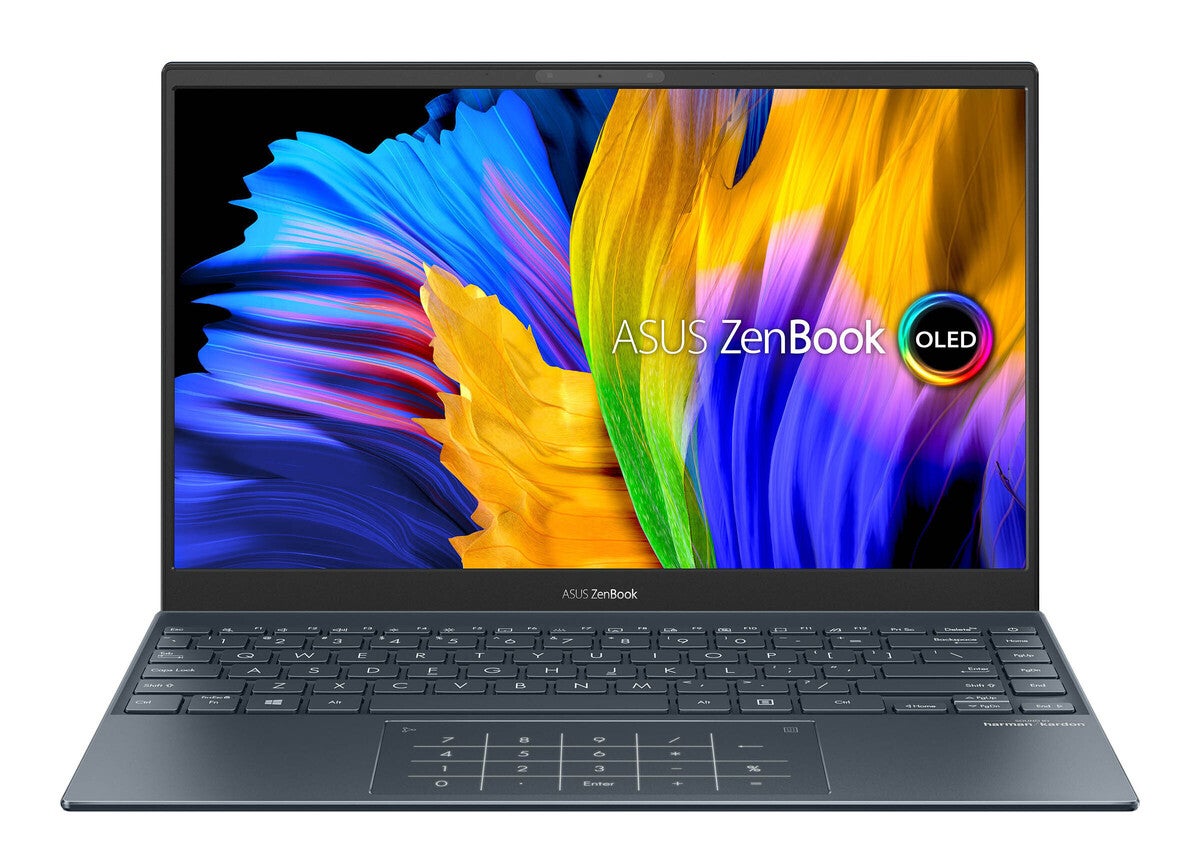 Asus
Asus The Asus ZenBook UM325 features AMD's newfound Ryzen 7 5800U.
How we dependable
For our examination we used the same two laptops from our Ryzen 7 5800U review:
- Asus ZenBook UM325. It features AMD's eight-core Ryzen 7 5800U, 16GB of LPDDR4X/4267, a PCIe 3.0 1TB SSD, a 65-watt-hour battery, and a 13.3-inch 1080p OLED, and it weighs 2.6 pounds.
- MSI Prestige 14. It features Intel's four-core 11th-gen Core i7-1185G7, 16GB of LPDDR4X/4267, a PCIe 4.0 512GB SSD, a 52-watt minute battery, and a 14-inch 1080p IPS-level screen, and it weighs 2.7 pounds.
It's important to note that there's almost no so much thing As an apples-to-apples equivalence with laptops. Intel and AMD give laptop makers the CPUs, only everything other is particularized to the vendor's plan for that system, from the presentation type and sized, to the cooling design and the keyboard and the battery. Esteem laptops instead as pairings of a specific design to a specific CPU—in this caseful, Asus ZenBook with Ryzen, and MSI Prestige 14 with Heart and soul i7. These two laptops were among the first out of the gate with their respective CPUs, so they are congresswoman of what to expect.
 MSI
MSI MSI's Prestige 14 EVO features Intel's 11th-gen Core i7-1185G7
Both laptops were running Windows 10 20H2 (Build 1904.867) and the a la mode drivers available. Windows 10 offers four power performance states you can select when exploitation. Reported to Microsoft documentation, they are:
Best Performance: Favors performance over power and is targeted at users who want to merchandise bump off power for performance and responsiveness. Available on both Alternating current (plug-in electricity) and DC (battery).
Better Performance: Default option slider mood that slightly favors performance over battery lifetime and is appropriate for users WHO want to trade unsatisfactory power for better carrying out of their apps. Accessible on both AC and DC.
Better Barrage fire: Delivers longer battery life than the default settings along previous versions of Windows. Available on both AC and DC. In much cases, users testament see this mode labeled Advisable, rather than Better Barrage, in their yellow-bellied terrapin UI.
Battery Saver: Helps conserve power, and prolong electric battery life, when the system is not connected to a power source. When assault and battery recoverer is along, some Windows features are handicapped, throttled, or behave differently. Screen brightness is also reduced. Battery Rescuer is only on tap on DC.
For our testing, we used only the first three modes, because it's understood that Electric battery Saver mode will involve a performance degradation. The ZenBook's nonpayment unplugged mode is Better Battery, while the Prestigiousness 14's is Better Performance.
Cinebench AC/Direct current Testing
We'll kick this off where we typically begin: Maxon's Cinebench R20 3D translation benchmark. It's a test built on the company's Cinema4D engine, which is integrated into Adobe's Premiere and After Effects, and is also sold standalone. Like all 3D moulding applications, it favors much Central processor cores and threads.
Along this and all charts to follow, we usher the AMD contribute red, and the Intel contribute profane.
In the first chart, for Cinebench multithreaded functioning, the top pair of parallel bars shows the stomping you've bear on expect when indentation an viii-meat Processor (AMD's Ryzen) against a four-core CPU (Intel's 11th-gen Heart and soul)—when running along AC, in any event. Once we switch to DC battery, for all other results shown below, you can see the forceful fall-off in carrying into action for the Ryzen-based Asus. The Little Jo-core Intel chip gets uncomfortably contiguous. However, you don't see steeper declines as you move through the depress operation/power stages.
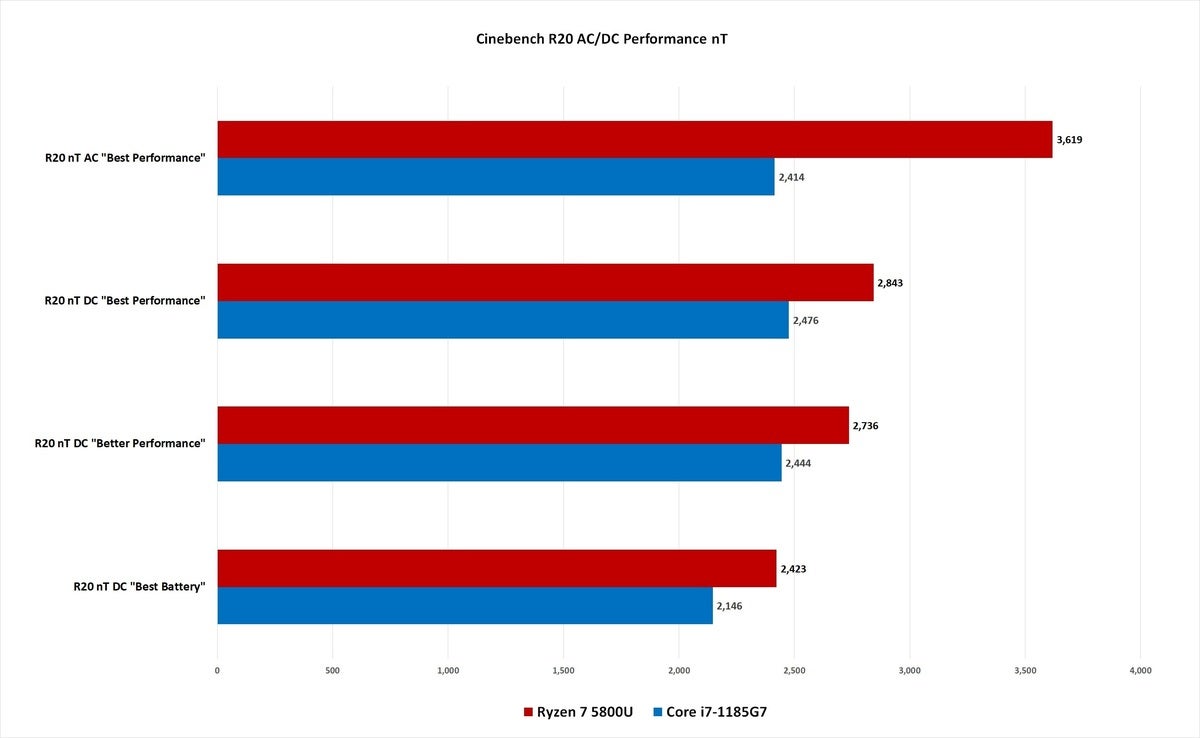 IDG
IDG In Cinebench multithreaded performance, the Asus/Ryzen startso ff ironlike on Ac, but lots almost of its advantage on DC. Longer parallel bars indicate better performance.
Exploitation Cinebench R20 set to a single thread, we can see both laptop/CPU combos exhibit very different behaviors. The Essence i7-1185G7 in the MSI basically doesn't locomote going from AC to DC in Charles Herbert Best Performance or Advisable Performance. Meanwhile, the Ryzen 7 5800U in the Ryzen is actually chugging in the Improve Battery place setting in single-threaded tasks.
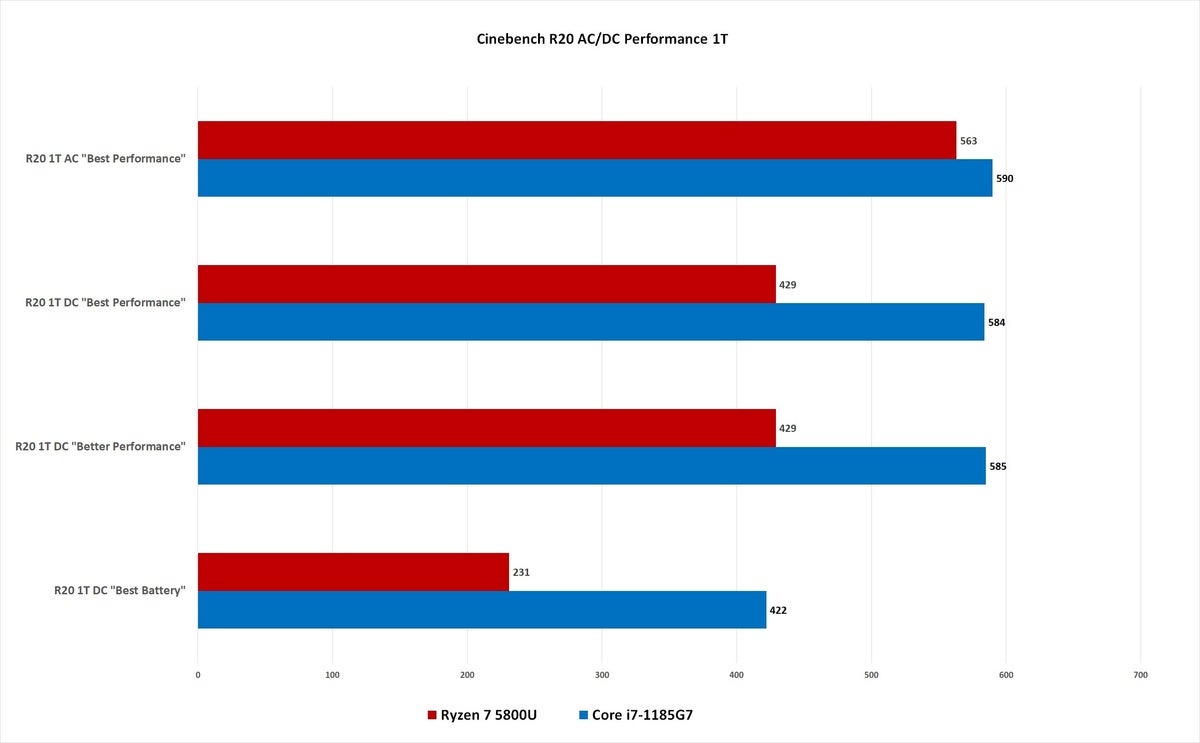 IDG
IDG In Cinebench single-threaded, the MSI/Intel sexual unio prevails, while Ryzen loses more ground as you pass across the different power settings. Longer parallel bars indicate better performance.
Countenance's take those Cinebench results and calculate at how both laptops compare as a percentage. In multi-core mode, you can see the Ryzen's advantage range from a whopping 50 percent to narrower leads functional on DC battery in the other power settings.
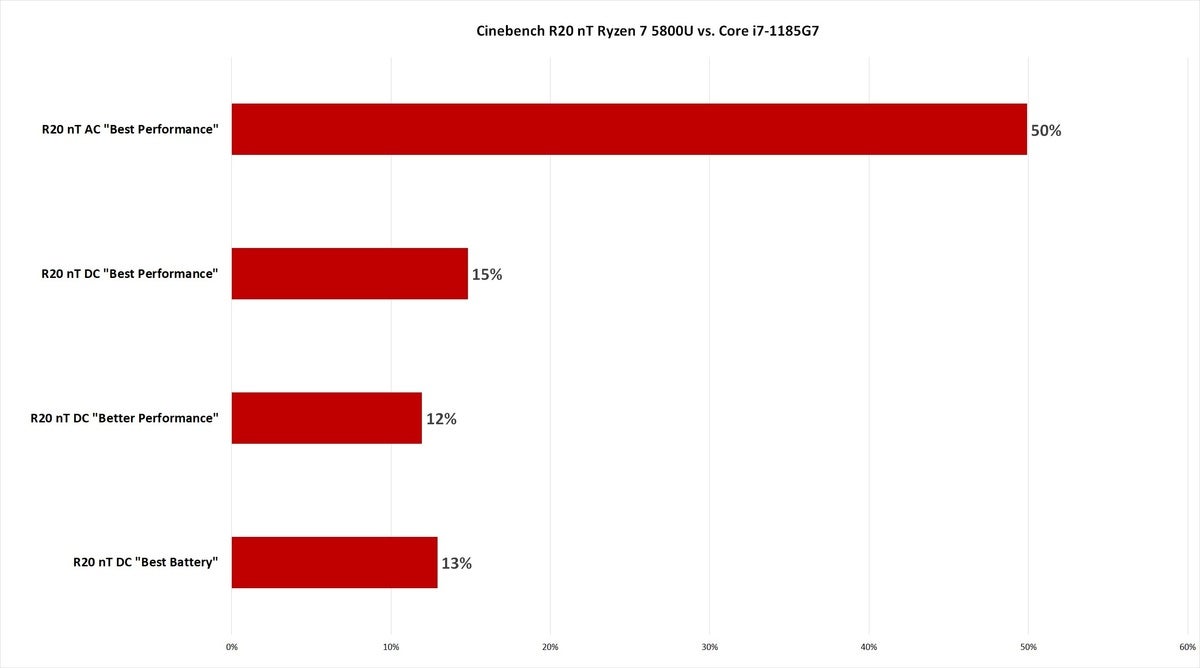 IDG
IDG Yearner bars indicate better performance. This is how much performance the Ryzen 7 5800U sheds vs. an Intel Core i7-1185G7 when plugged or spurting on batteries, using three different Windows Power Performance Slider settings.
In single-threaded public presentation we see an upside-down chart. That's because while the Prestige 14/Core i7 was actually competitive with the ZenBook/Ryzen 7 connected AC, we're look a 27-percentage to 45-per centum lead-in for Intel on the DC battery settings. That's a major difference, and we'll verisimilar hear this manifest itself later on.
 IDG
IDG The AMD Ryzen 7 5800U laptop is forever behind the Heart and soul i7-1185G7 laptop and drops far depending on the Windows force slider setting.
Ryzen vs. Core i7: Photoshop and Lightroom AC/Direct current
We know very few people perform 3D modelling surgery rendering connected a 13-in ultraportable laptop computer, so we utilization Adobe Photoshop 22.3 and Lightroom Standard 10 with UL's Procyon Exposure trial as something that's popular but non precisely whippersnapper, and still CPU- and GPU-intensive. Genus Procyon runs both Adobe apps through a put across of scripted tasks while measuring the response.
The good news for Ryzen in the Asus ZenBook is IT's outpacing Intel's best U-class CPU in the MSI laptop computer. The nagging problem, though, is once you're connected battery, even on the laptop's "Best Performance" setting, the ZenBook and Ryzen 7 are big up 24 percent in performance in Photoshop and Lightroom against the Intel/MSI pair.
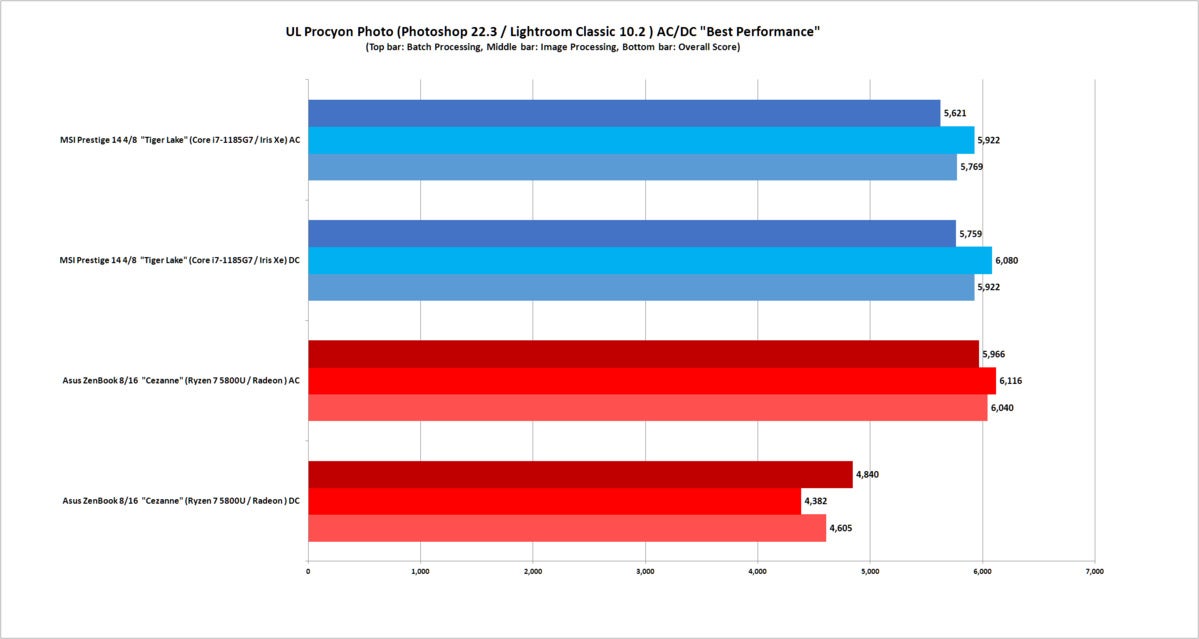 Gordon Mah Ung/IDG
Gordon Mah Ung/IDG In the Procyon bench mark, Intel/MSI holds surefooted in the "Superfine Functioning" setting, while Ryzen/Asus falters when on bombardment. Longer parallel bars indicate better performance.
Execution gets smooth harsher for the ZenBook/Ryzen 7 running happening the Better Shelling setting. IT's basically cut in half versus the MSI Prestige 14/Core i7.
 Gordon Mah Ung/IDG
Gordon Mah Ung/IDG In the same Procyon benchmark only on the "Better Battery" setting, the Ryzen/Asus laptop falls even further behind when connected Direct current assault and battery. Yearner bars indicate better performance.
With such a powerful suite as Photoshop, what you do fundament influence execution. We buzz off a second opinion from workstation builder Puget Systems and its PugetBench 0.93 test.
We again see the Prestige 14 and Core group i7 hold steady in performance between Ac and DC using the "Best Performance" setting. The ZenBook and Ryzen 7 jazz band over again sees a drop in performance from Atomic number 89 to DC.
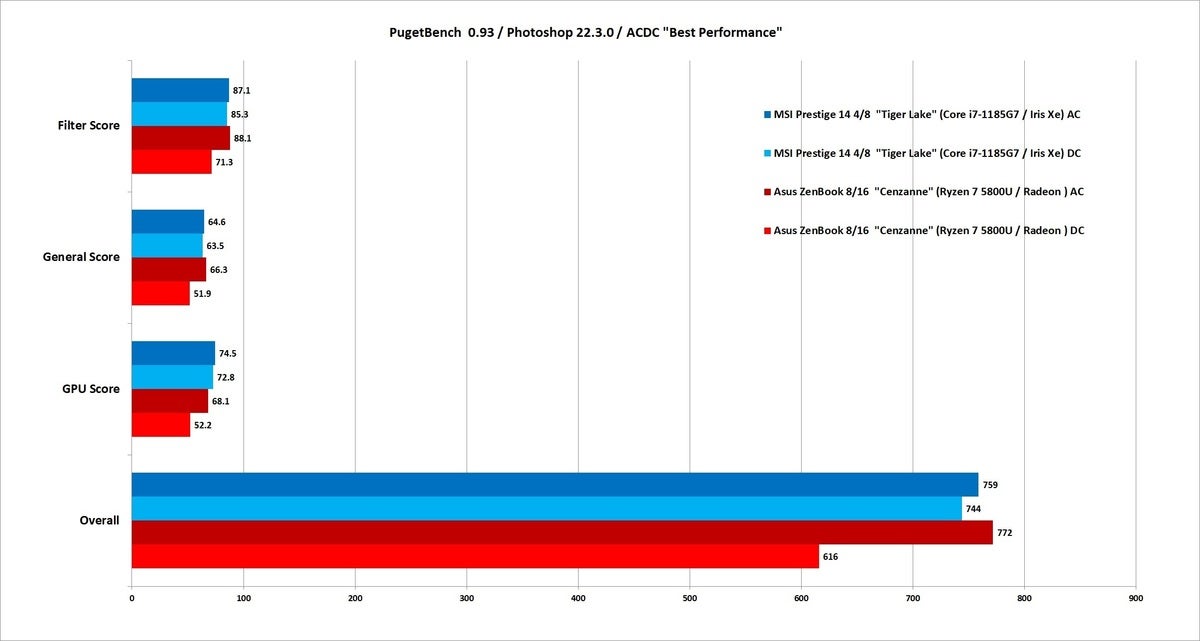 IDG
IDG In PugetBench, the Sung cadaver the same: Asus/Ryzen drops back when on battery. Longer bars indicate better performance.
As with Genus Procyon, PugetBench for Photoshop again sees a pretty drastic performance drop on "Fitter Battery."
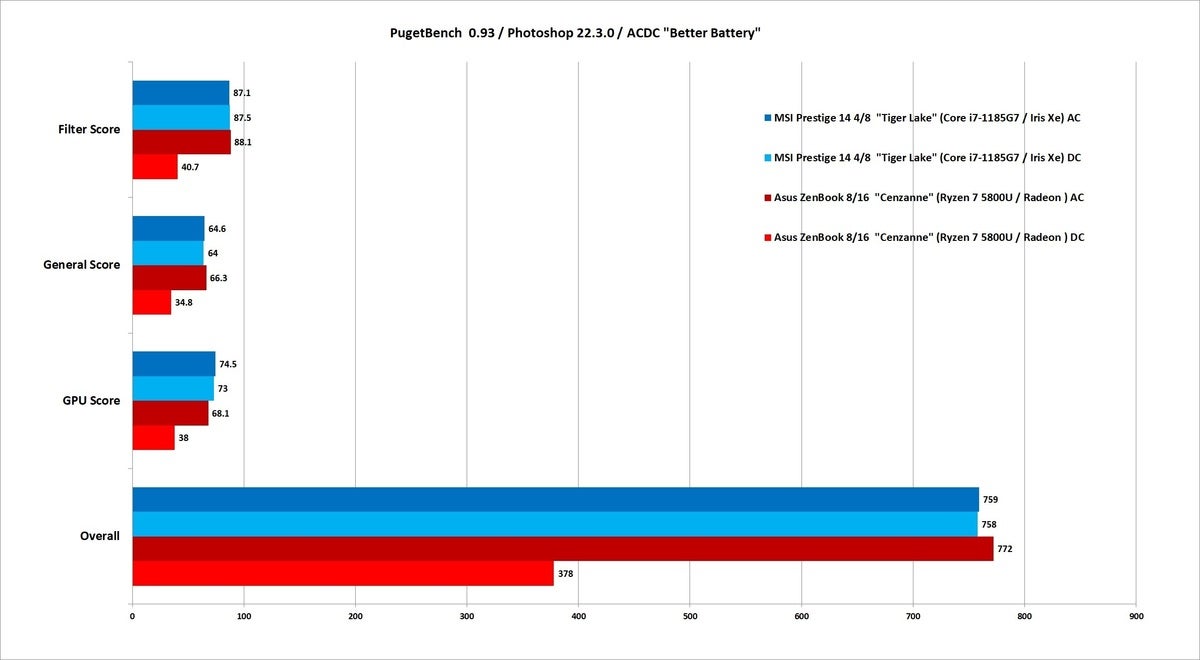 IDG
IDG The Asus/Ryzen laptop falls more precipitously in ProCyon in "Finer Battery" mode. Longer bars indicate better performance.
Keep reading for performance in Office, March browser, and more
Ryzen vs. Core i7: Office Alternating current/DC
Let's Be honest, just about citizenry wish they could be editing photos from a month-long trip to Bali on their 13-inch ultraportable, merely they're more expected massaging Word and Excel files, or fashioning a PowerPoint presentation using pictures from their hirer's trip to Bali.
To look at Federal agency performance under AC operating theater DC conditions, we use UL's PCMark 10 Application, which, like Procyon, uses the nourished version of Function 365 to test Book, Excel, PowerPoint, and Border performance.
The big win for the ZenBook/Ryzen has been its performance under AC, where, despite the very lightweight nature of Office, information technology actually beats the Prestige 14/Heart i7 mating.
Disconnect the ZenBook and Prestige 14, and we see the Intel Pith i7 jump to the first. We'd argue you'd hardly feel it in nigh tasks, just it is a trifle eyebrow-raising to see the performance of the Ryzen 7 in Stand out sharply drop off by 30 percent. Again, we're using the "Best Performance" setting.
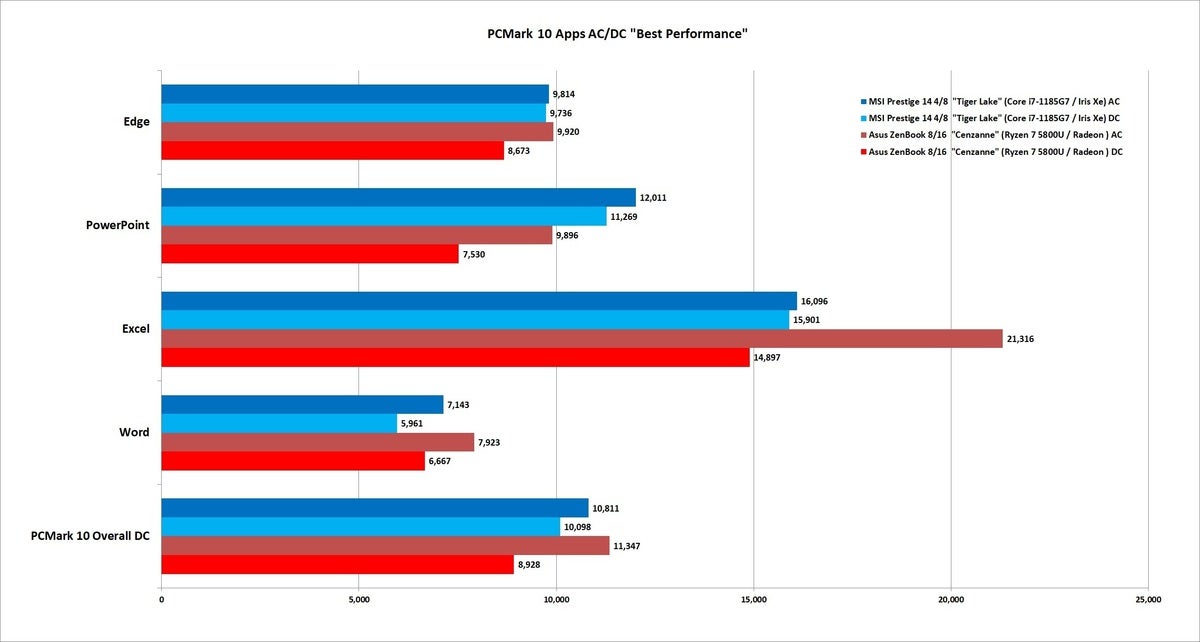 IDG
IDG The Asus/Ryzen laptop's Excel performance takes a drastic tally in performance along battery. Thirster parallel bars suggest ameliorate performance.
Moving the Windows 10 slider to "Better Battery," we now see some laptops' results slack off quite a minute. The Prestige 14/Core i7 remains in front of the ZenBook/Ryzen 7, which once more gives in the lead almost half.
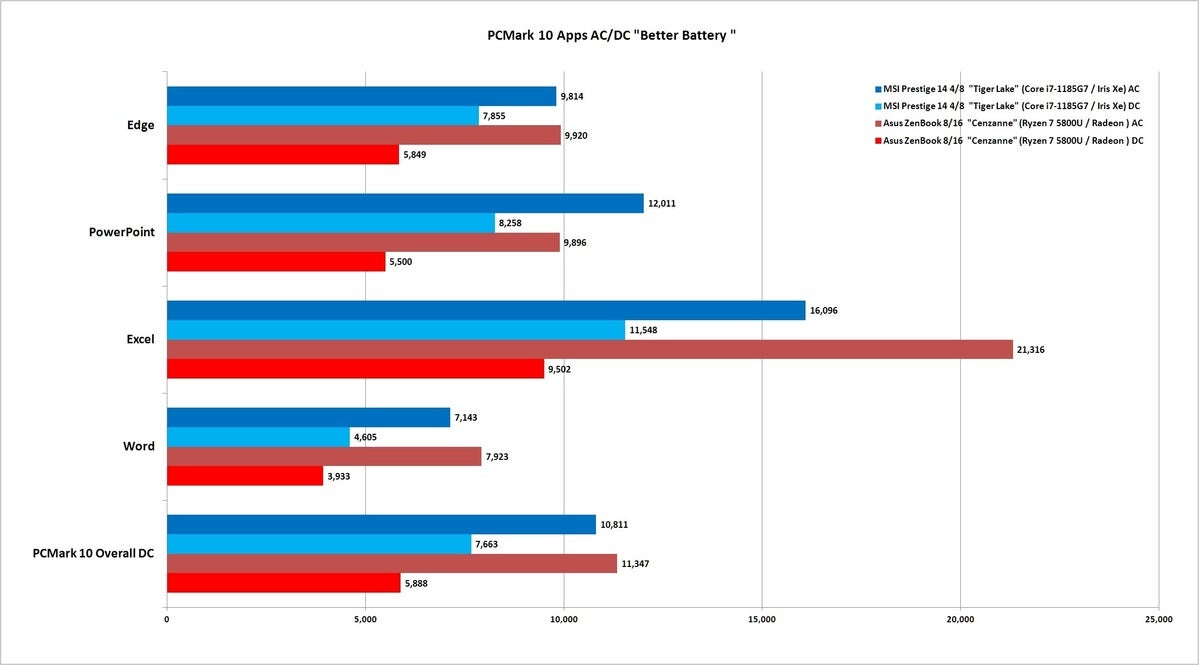 IDG
IDG In "Improved Shelling" modality, both laptops yield a expend, merely the Asus/Ryzen falls further. Thirster bars indicate better performance.
Ryzen 7 vs. Center i7: Browsing AC/DC
We'll step rearward to an even lighter-duty labor, but one that many people do on a tiny laptop unplugged: Graze the web. To gauge carrying out we ran both laptops done Principled Technologies' WebXPRT 3, also As JetStream 2, MotionMark 1.1, and Speedometer 2.0.
As we did above, the darker blue represents Intel connected AC, while the darker red represents AMD on AC. The lighter colours represent DC public presentation with the Windows 10 slider plant to "Best Performance." We used the same version of the Google Chrome 90 for both laptops.
Once more, the macro win here for AMD is connected AC in the ZenBook, where it's now performing ahead of Intel's better low-power Central processor in WebXPRT 3. The other tests as wel show it to beryllium mostly a back-and-forth—on AC.
Unplug those laptops, though, and we instantly have a opaque lead across the board for the Intel/MSI pairing.
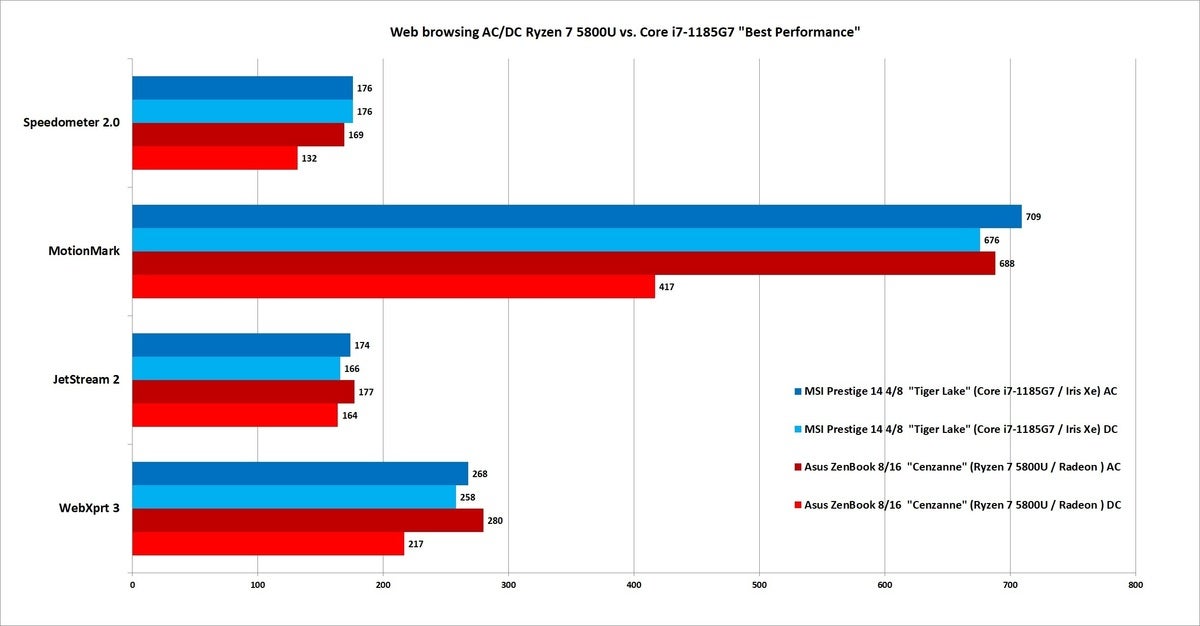 IDG
IDG In web browser benchmarks on "Best Performance," Ryzen is competitive leave out on battery. Thirster bars indicate better performance.
Set the laptop to its "Better Battery" test, and both laptops come down off in performance equal more—but the Ryzen 7 in the ZenBook falls off furthest. WebXPRT 3, for example, shows about a 30-percent pretermit for the Core i7, while the Ryzen sees closer to a 50-percent performance throw off.
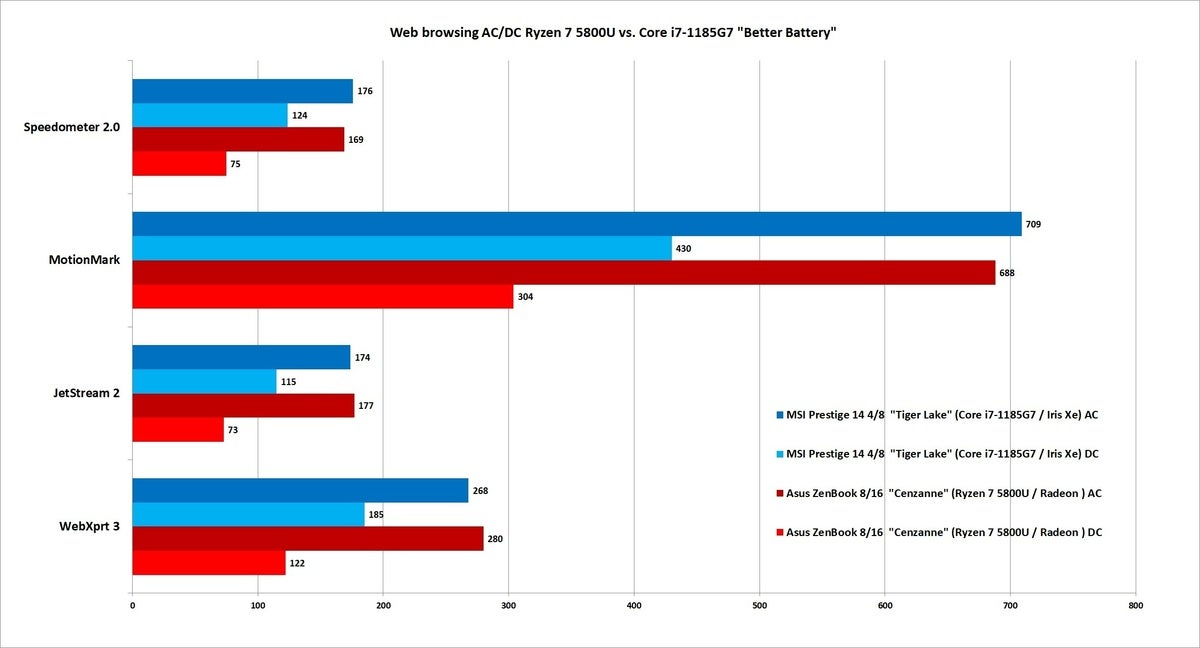 IDG
IDG Move knock down a notch to "Better Battery" in Windows, and Ryzen falls farther off the stigmatise. Longer bars indicate better performance.
What about mightiness use?
It's impossible to separate the laptop from the Processor when speaking about battery life. What screen is used, how much computer memory, how good the motherboard's baron modules are, number one wood optimization, and battery capacity all put up to the laptop's endurance.
Our official test for battery rundown loops a 4K video, with the laptop set to aeroplane mode and its screen coif to 250 nits to 260 nits' luminance. We also set the bulk to medium and wa in earbuds.
As you can envision in the chart below, the OLED Asus ZenBook and its honking-big 65-W-hour battery (dark red bar) does jolly healed, exceeding 12 hours of run metre. The MSI Prestigiousness 14 also just breaks 12 hours with its smaller 47-watt-hour barrage. However, this is a pretty easy test, and your mileage will alter depending on what you really do.
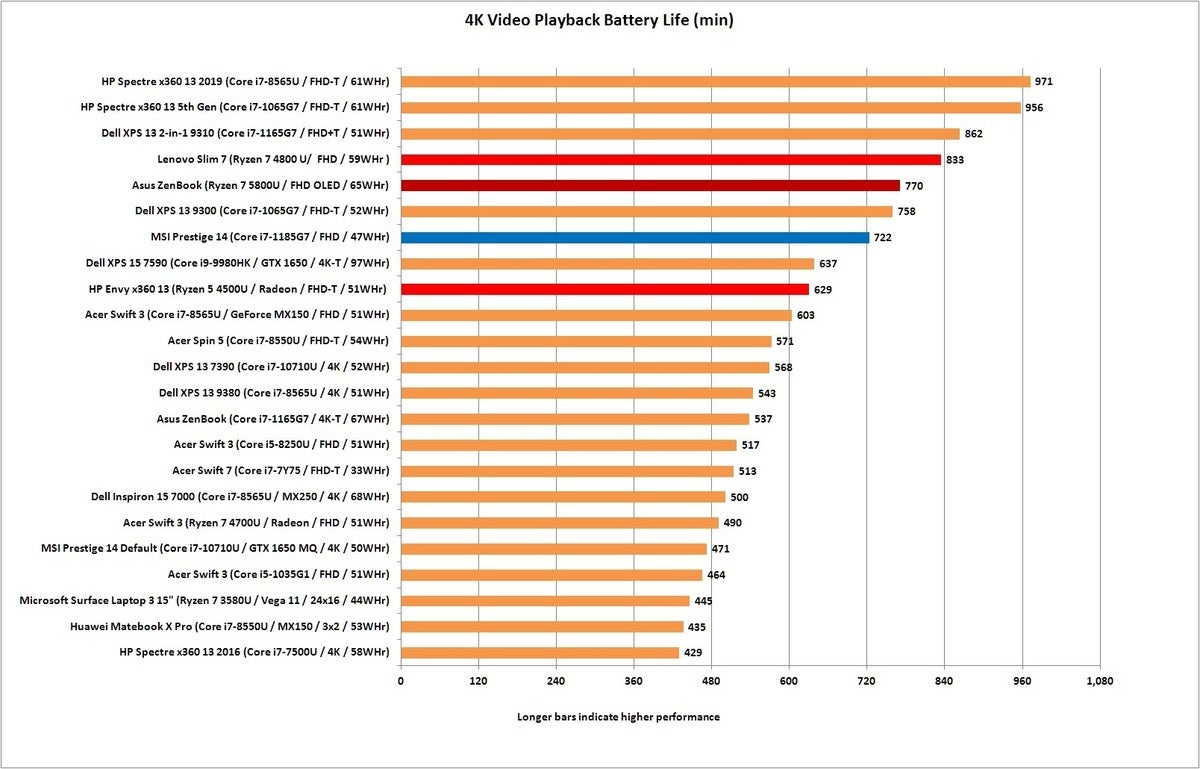 IDG
IDG Neither laptop computer has anything to glucinium ashamed of in batter biography. Longer bars indicate better performance.
So we took it a footstep further and looked at how much power is exhausted in the laptops during many of the tests. Reported wattage doesn't forever translate to direct battery life, so instead we half-tracked the barrage discharge rate of the laptops patc running some of the tests again, unplugged. Every watt used denotes a drain on your stamp battery.
Below you can examine both laptops running Cinebench R20. The first run is using the "Better Assault and battery" scene in Windows 10, while the second is using the "Best Performance" setting. The result is in milliwatts.
You can see break u of the sorcerous of the Core i7 in the MSI on battery is due just to using more power—sometimes a lot more. In the first base Cinebench R20 run for, it's almost a 40-watt load, spiking adequate to a massive 70 watts in "Top-grade Performance" mode before completing the run more often than not in the 55-watt to 50-watt range.
The Ryzen 7 in the ZenBook is farthermost easier on the gas, with the battery discharge pace at roughly 15 watts in "Best Bombardment" and all but 20 Watts in "Champion Performance."
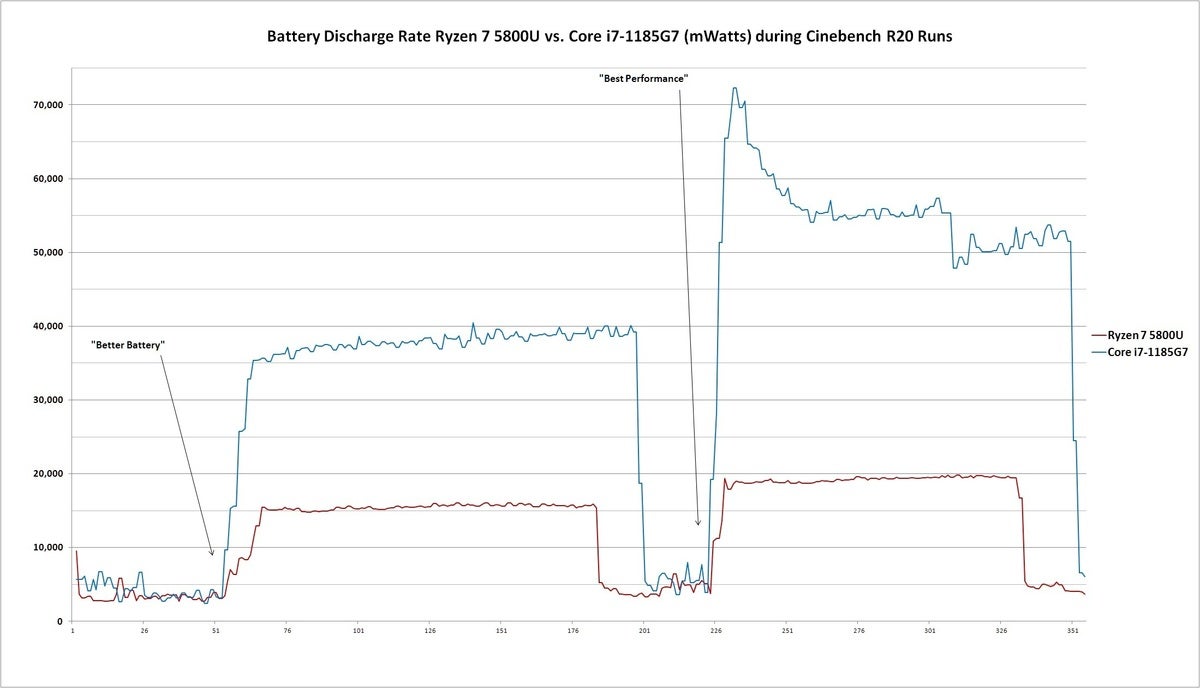 IDG
IDG You send away check the Core i7-1185G7's tendency to run full-tilt in the MSI Prestigiousness 14 puts a much heavier charge on the battery than does the Ryzen 7 5800U in the ASUS ZenBook.
As you can guessing, putting that heavy-footed of a load connected a shelling means you'll run IT down far faster. In our testing, the slit in the MSI Prestige 14's battery was visibly different later on the Cinebench runs, dissimilar with the Asus. To be fair, the Asus's battery is 38 pct larger, indeed any simplification in capacity appears larger on the MSI. But more king used means less run time, no matter how you cut information technology.
An all-core load is motionless same atypical of what most the great unwashe brawl, and so we also looked at the discharge pace of both laptops doing everyday practical browse.
Below you can see WebXPRT 3 running on Google Chrome 90 in "Best Performance" mode, and then "Better Battery," on both laptops. The Intel-supported laptop computer cared-for have casual high-boost clocks, which led to short spikes in electric battery discharge rates.
After these runs, the reduction in the Prestigiousness 14's battery wasn't as noticeable. For those World Health Organization for the most part do short, light boosty work, any disparity between Intel and AMD rival CPUs won't be as apparent.
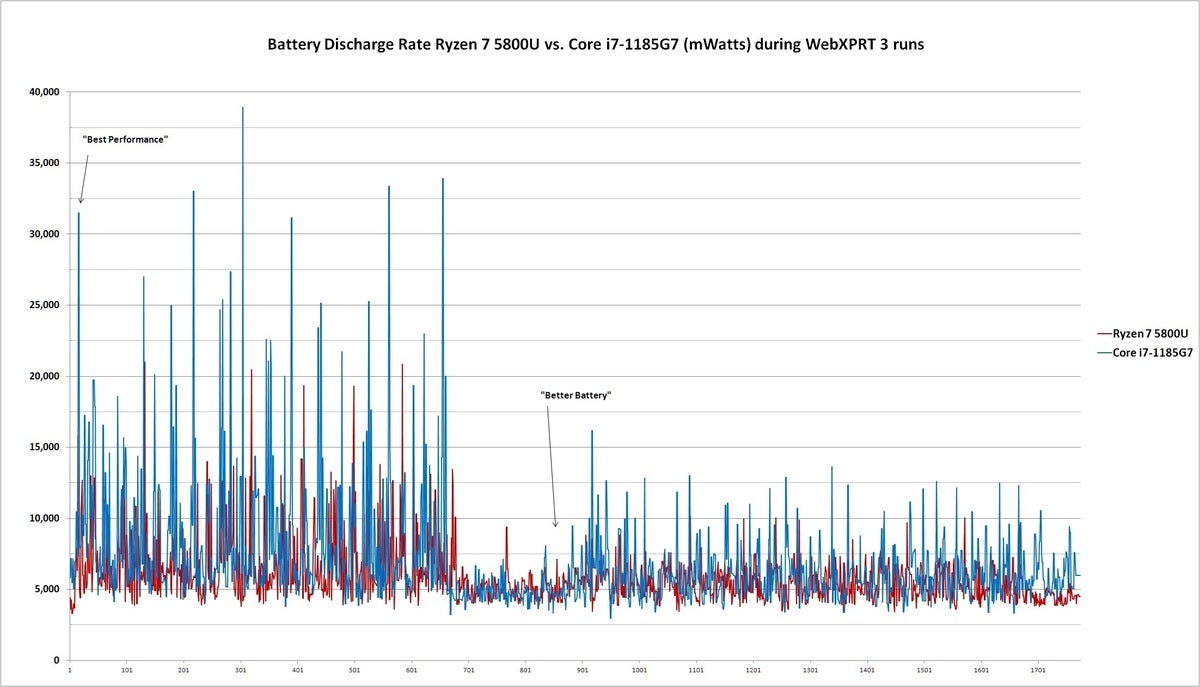 IDG
IDG The MSI Prestige 14 and Core i7-1185G7 will run into the assault and battery harder than the Asus ZenBook and Ryzen 7 5800U, but in lighter tasks the departure isn't arsenic forceful.
It's not like Intel is stressful to conceal its power use. Looking at at this slide on a lower floor from its presentation when information technology originally launched its Panthera tigris Lake last year.
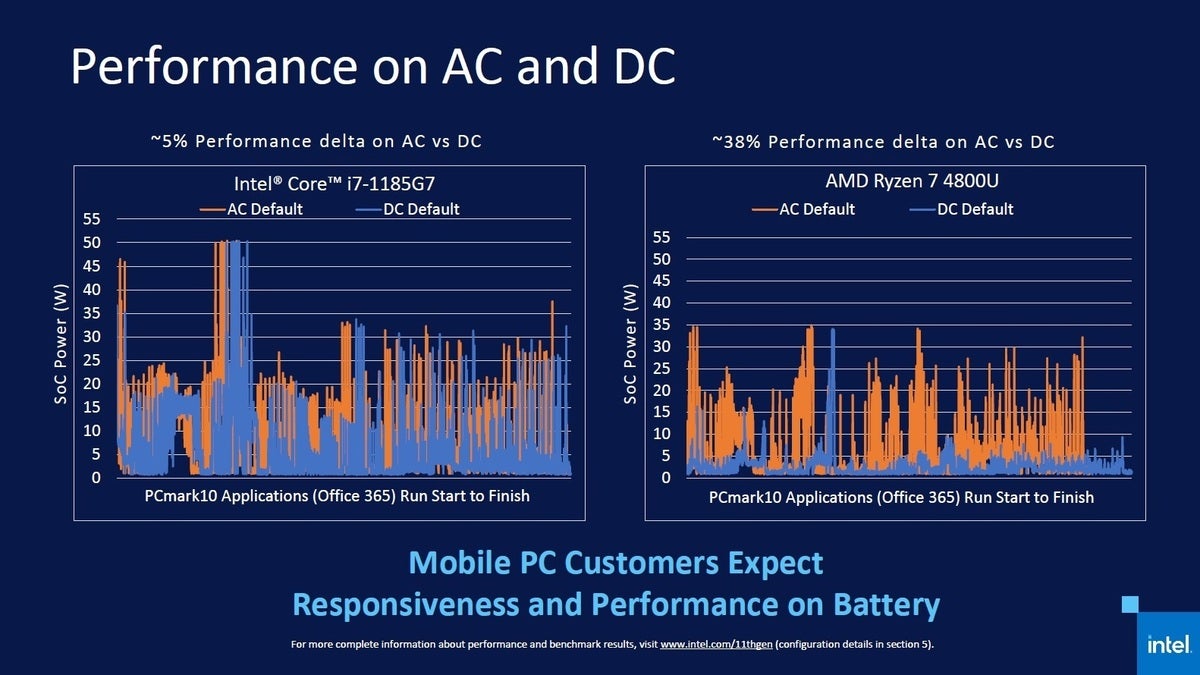 Intel
Intel In its presentation, Intel basically was already saying Ryzen's execution is to a great extent nerfed fair-minded based on the wattage the Saratoga chip consumes vs. the wattage the Core i7 consumes. Of run, Intel doesn't show you that much wattage used also means less available battery animation.
Who's right—Intel or Ryzen?
If you're looking for undisputed winners and losers, you'ray non going to find them in this story. Intel's 11th-gen CPUs and AMD's Ryzen 5000 motorized CPUs are display different philosophies in how to build the best consumer know.
With Tiger Lake, Intel seems to buy into the concept of accretionary performance perceptual experience by giving you a very short boost to keep the laptop as responsive as possible—justified when on battery. You launch Word Oregon Chrome and start browsing, and the laptop computer bequeath lace up to very high clock speeds, and very high-stepped and short-length wattage use.
The weakness in Intel's approach, obviously, is the sacrifice of battery life to amaze that responsiveness. If you want to mash the pedal day in and day out and use up your battery at the highest performance—go right ahead.
Ryzen and the laptops we've seen so far with it, appear to favor a far more conservative approach—sacrificing performance to become as much run time as possible, all of the prison term. That high boost response Intel give you is great—but not if it means you've eaten up your battery to get there.
The weakness in AMD's approach, at to the lowest degree implemented here, is dampening performance all of the time to save the battery. In our testing, we never got the same performance out of the ZenBook and Ryzen 7 on battery as we could when plugged in. That's great—if everyone's goal is extending the battery life. But some masses truly want or deman to crank IT up, which runs counter to that slow-and-steady scenario.
The short answer to the motion we started with is yes, Ryzen, even in the newest Ryzen 7 5800U, suffers—sometimes greatly—when running play on battery in the Asus ZenBook. And yes, to beryllium fair, we have to allege the Core i7-1185G7 in the MSI Prestigiousness 14 doesn't hand out raised performance on battery—merely it drains that battery dry some faster too.
In the end, chose the doctrine that kit and boodle best for what you need in your laptop, and drive on.
Source: https://www.pcworld.com/article/394476/tested-is-ryzen-5000-battery-performance-really-that-bad.html
Posted by: hareouste1951.blogspot.com


0 Response to "Tested: How bad is Ryzen 5000 battery performance? - hareouste1951"
Post a Comment